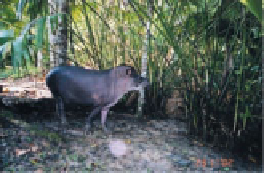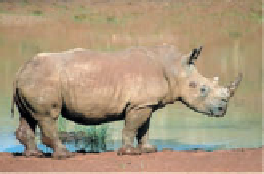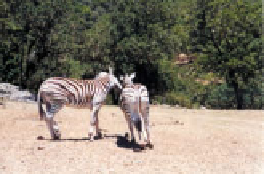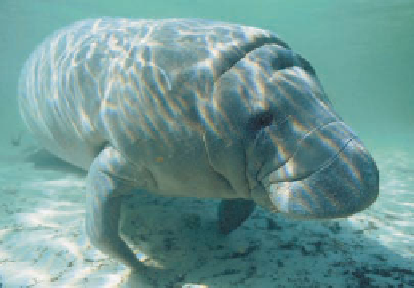Geology Reference
In-Depth Information
the fused clavicles typical of birds. These creatures, known as
Archaeopteryx
, have precisely the features we would expect in a
transitional animal between reptiles and birds (see Chapter 22).
Horses, rhinoceroses, and tapirs may seem an odd as-
sortment of animals, but fossils and studies of living animals
indicate that they, along with the extinct titanotheres and
chalicotheres, share a common ancestor (
should become increasingly diffi cult. And, in fact, the earli-
est members of each are remarkably similar, differing mostly
in size and the details of their teeth. As diversifi cation pro-
ceeded, though, the differences became more apparent.
Little was known about the ancestry of dugongs and
manatees, collectively called sea cows, until 1994. Then fos-
sils were found of a Middle Eocene animal known as
Pezosi-
ren portelli.
This sea cow had legs capable of supporting the
animal on land, whereas sea cows today have limbs modifi ed
Figure 18.18).
If this is true, we can predict that as we trace these animals
back in the fossil record, differentiating one from the other
◗
FPO
Tapir
Rhinoceros
Horse
(zebra)
◗
Figure 18.18
Cladogram Showing the Relationships Among
Horses, Rhinoceroses, and Tapirs (Order Perissodactyla) These
relationships are well established by fossils and by studies of
living animals. When these animals fi rst diverged from a common
ancestor, all were remarkably similar, but as divergence continued,
they became increasingly different.
◗
into paddles (
Figure 18.19).
Pezosiren portelli
is truly a transitional fossil, as are others that we
will discuss in the following chapters.
Of course, we will never have enough fos-
sils to document the evolutionary history of all
living creatures, simply because the remains of
some organisms are more likely to be preserved
than those of others, and the accumulation of
sediment varies in both time and space. Nev-
ertheless, more and more fossils are found that
clearly show ancestor-descendant relationships
among many organisms or that help clarify evo-
lutionary trends within specifi c lineages.
◗
Figure 18.19
Living and Fossil Sea Cows
The Florida manatee
or sea cow is a large, fully
aquatic mammal living
in the coastal waters of
Florida and Georgia.
a
Scientists are convinced that evolutionary theory
is as well supported by evidence as any major
theory. Indeed, studies as diverse as molecular bi-
ology and paleontology all confi rm evolutionary
theory—that is, organisms living today descended
with modifi cation from ancestors that lived dur-
ing the past. Certainly, scientists disagree on
specifi c issues such as rates of evolution, the sig-
nifi cance of some fossils, and precise relationships
Skeleton of
Pezosiren portelli
found in Jamaica, an
Eocene sea cow with four well-developed legs.
b








Search WWH ::

Custom Search